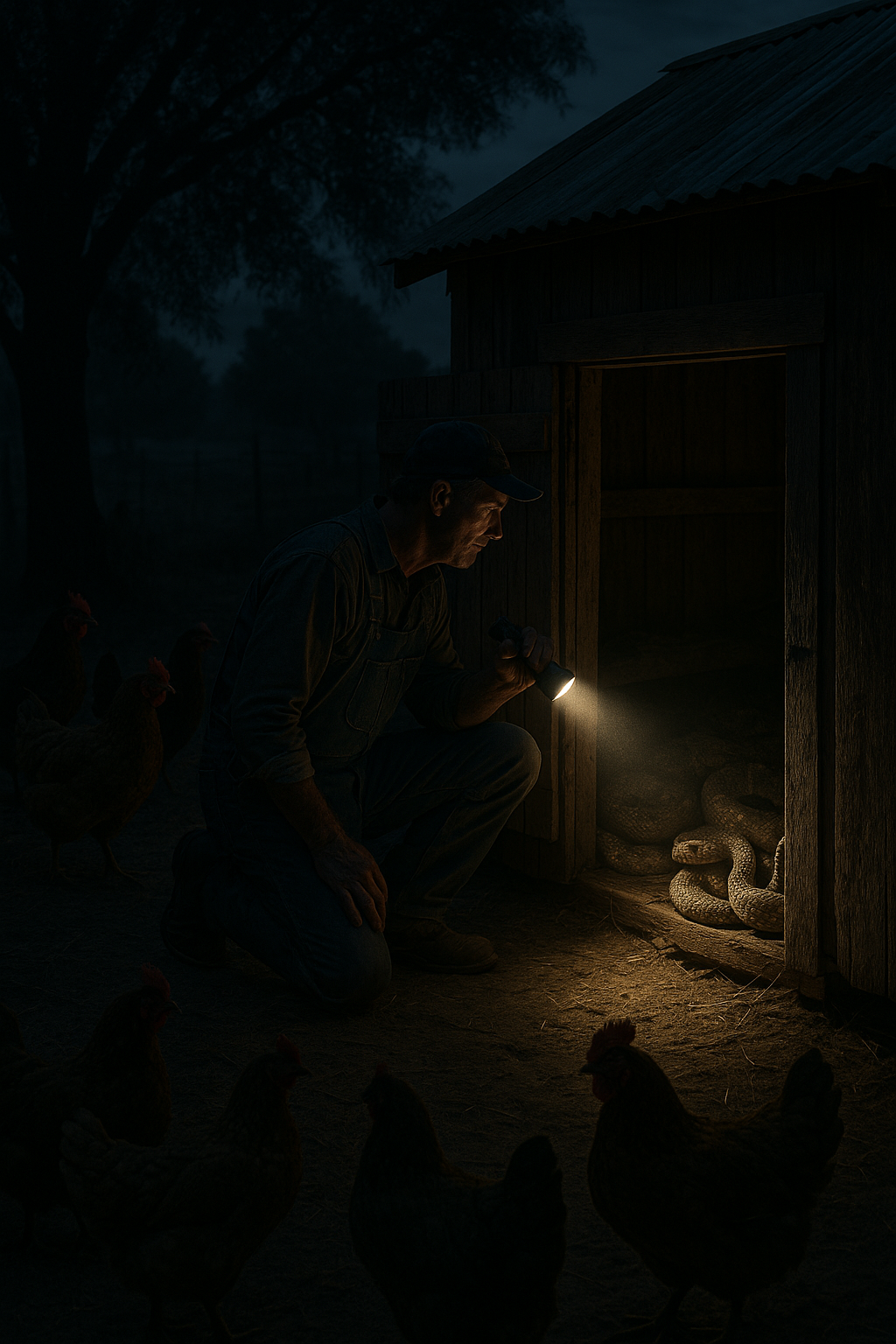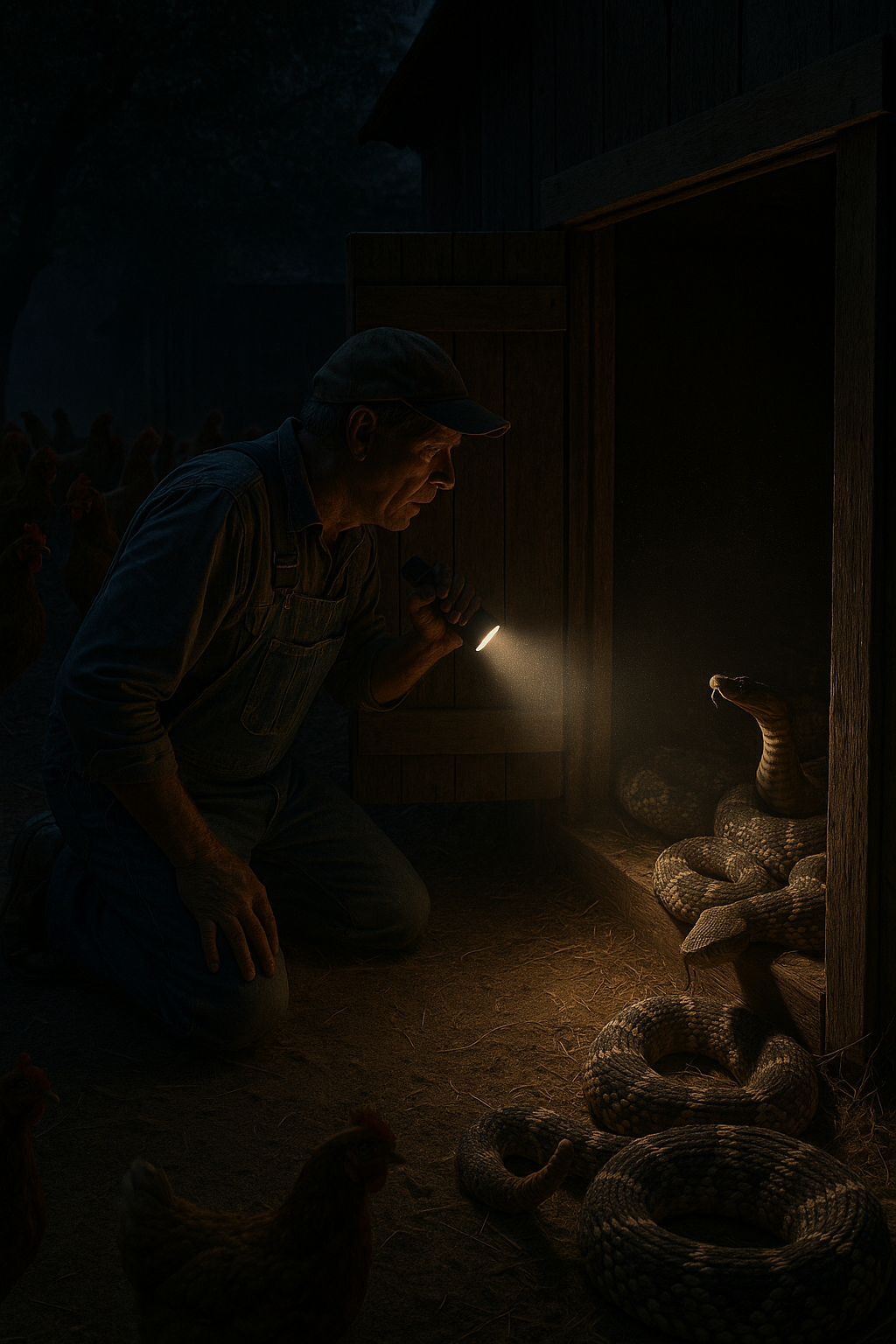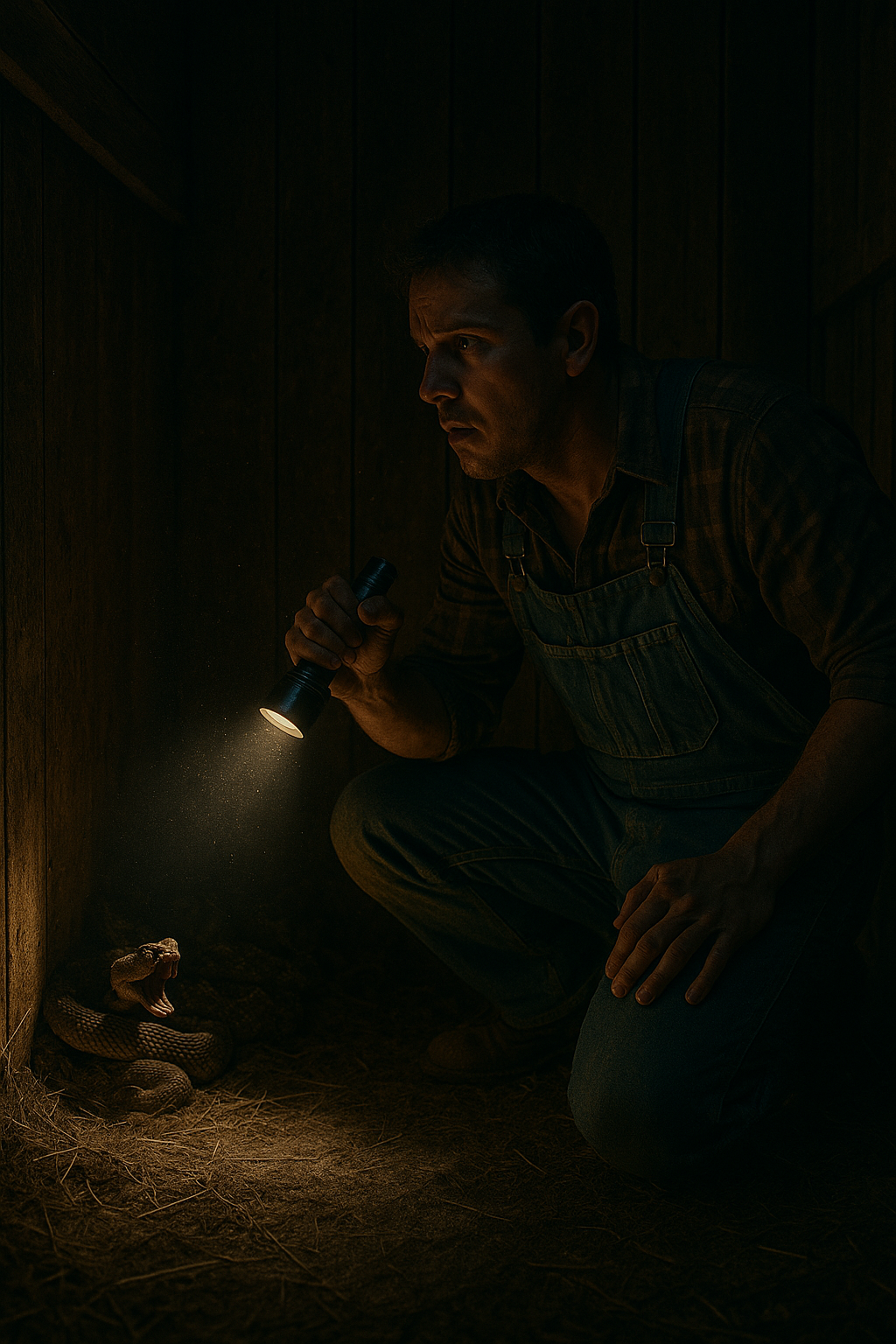The Silence Beneath the Coop
In the rolling farmland of rural Arkansas, where long rows of soybeans met the edges of pine thickets, fifty-three-year-old Dale Henderson had always believed his life was predictable. He liked it that way. His farm wasn’t the biggest in Boone County, nor the wealthiest, but it was steady, quiet, and his own.
Every morning before sunrise, he laced up his worn boots, filled a metal bucket with grain, and walked toward the chicken yard. The sound of thirty Rhode Island Reds clucking and scratching was his alarm clock, his comfort. Their steady rhythm matched his own heartbeat — a reminder that life, in its simplest form, could still be good.
The routine never failed him. At dusk, the flock would waddle into their wooden coop, one after another, as if they were soldiers obeying orders. Dale would bolt the door, lean against the fence for a moment, and admire the darkening sky. Then, at first light, he’d step inside and collect neat rows of brown eggs from straw-lined boxes, still warm from the hens’ bodies.
That was life. That was stability.
And then, in late September, the rhythm broke.
The First Night of Refusal
It happened on an evening that looked like all the rest. The sun was dipping behind the low hills, painting the horizon in ribbons of orange and purple. Dale stood by the coop door, waiting, the way he always did. But instead of marching in, the hens stopped short beneath a broad oak tree. They clustered together in the fading light, restless and noisy, feathers ruffling as though a strong wind passed through them.
“C’mon, girls,” Dale muttered, tossing grain at the coop entrance.
The birds didn’t budge. A few stepped forward, pecking curiously at the corn, but when he clapped his hands to encourage them, they panicked and scattered. Their wings beat the air in frantic bursts, and then they huddled back under the tree, staring at the coop as if it were something alive.
That night, Dale carried two of the stubborn hens inside himself, shutting the door behind them. But within minutes, they flapped against the walls until they managed to escape through a small gap in the boards. By the time Dale got to the yard again, both had flown up into the branches beside the others, choosing the cold, rough bark over shelter.
He frowned, confused, but chalked it up to some passing quirk.

Patterns That Didn’t Break
The next night, the same thing happened. And the next. For three long weeks, his thirty hens refused the coop.
Rain lashed across the fields one evening, soaking the yard. Yet even drenched to the bone, the flock perched miserably in the oak tree rather than step inside the shelter Dale had built for them. He tried everything — scattering fresh straw inside, scrubbing out every inch of the coop, even leaving the door wide open with a trail of feed leading right in.
Nothing worked.
The chickens would walk close to the doorway, pause, and then freeze as if something invisible pressed against them. They’d flutter backward in a wave of squawks, the air vibrating with alarm.
At first, frustration gnawed at Dale. Chickens weren’t supposed to be this stubborn. He cursed them under his breath, scolded them aloud, and even considered locking them inside for a few nights. But deep down, a different feeling started to grow: unease.
Animals didn’t act like this for no reason.
Memories of His Father
On the fourth night, as Dale sat on his porch staring at the dripping branches, a memory came to him. He was twelve years old again, trailing behind his father through the woods. His father had stopped suddenly, holding up a hand.
“Animals sense before we do,” the old man had whispered, pointing toward the brush. “Deer freeze when there’s a mountain lion. Birds scatter before a storm. Don’t ever think you’re smarter than instinct.”
Minutes later, Dale remembered, a copperhead slid across the trail ahead, scales catching the sun. His father’s words had clung to him ever since.
Now, decades later, watching his own chickens refuse shelter, those words felt heavier than ever.
Seeking Answers
By the second week, worry overcame irritation. If the flock kept roosting outside, predators would strike sooner or later. Dale knew the woods were full of dangers: owls hunting at night, raccoons raiding farms, coyotes slipping through fields on silent paws. His hens wouldn’t stand a chance.
Finally, he called his local veterinarian, Dr. Sarah Mills, a woman in her forties who had cared for his animals for years. She drove out one crisp afternoon, her truck tires crunching over gravel, and followed Dale into the yard.
The hens were there as always — restless, uneasy, their eyes fixed on the coop. Dr. Mills crouched down, studying them, then straightened and walked to the door.
“Nothing’s wrong with your flock,” she said after examining their wings and eyes. “They’re healthy. But they’re avoiding this place for a reason.”
Dale raised an eyebrow. “What kind of reason?”
She gave a small shrug. “Could be smell, sound, vibration. Animals know when something is off long before we do. If I were you, I’d check inside carefully.”
Her words sent a chill down Dale’s spine.

Entering the Coop
That night, after his chores were finished and the yard fell into silence, Dale fetched his flashlight. He crouched at the coop’s narrow entrance, heart thudding louder than he liked. He hadn’t stepped inside in weeks, not since the hens had stopped using it.
The familiar smell of hay and wood dust filled his nose as he crawled forward on his knees. The beam of light swept across the nesting boxes, the fresh straw, the roosting beam above. Everything looked ordinary. For a moment, he exhaled in relief.
Then the light caught movement in the far corner.
At first it looked like a pile of patterned rope, coiled tight against the boards. His mind fumbled to make sense of it. And then the sound came — low, sharp, unmistakable.
The shape shifted. Another coil gleamed. And then another.
Timber rattlesnakes.
Shock and Realization
Dale’s breath seized in his throat. He scrambled backward so fast he nearly tripped, hands scraping against the rough doorway. When he burst outside into the cool night air, his chest heaved as if he’d run a mile.
The chickens hadn’t been stubborn. They hadn’t been misbehaving. They had been warning him all along.
Bolting the coop door shut with an old plank, Dale stood trembling in the yard, staring at the structure that had once symbolized stability. He had grown up in Arkansas. He had seen snakes before. But never like this.
Timber rattlers were among the most dangerous snakes in the region — thick-bodied, venomous, their strikes lightning-fast. The thought of reaching blindly into a nesting box and brushing against one of those heavy coils made Dale shudder so hard his teeth clicked.
And worst of all, he realized with horror, he had been walking within feet of them every single day for weeks.
The Lingering Fear
The coop sat silent for days after the snakes were removed, but Dale couldn’t shake the image of those coiled bodies tucked into the corners. He’d grown up around the Arkansas woods, but rattlesnakes inside his chicken house—that was different. It wasn’t just about the hens anymore. It was about safety, his family, and the unsettling reminder that nature has its own way of reclaiming forgotten corners.
For a week, Dale left the coop bolted shut. His chickens continued to roost under the oak tree, their instincts sharper than his. He set up a temporary shelter with an old tarp and some pallets, just enough to shield them from rain. Every night, when he watched them flutter into the makeshift roost, he felt both gratitude and shame. Gratitude because they had warned him. Shame because he hadn’t listened soon enough.
One night, over a cup of black coffee, Dale called his son Michael, who lived an hour away in Little Rock.
“Snakes, huh?” Michael said after a long pause. “Dad, that’s serious. You should tear the whole coop down.”
“I thought about it,” Dale admitted, staring through the kitchen window at the dark yard. “But this old coop’s been here for twenty-five years. Built it myself. Hate to just give up on it.”
Michael sighed. “Snakes will come back if there’s a way in. You need to decide if you’re keeping chickens safe or holding onto memories.”
The words stung, because they were true. Still, Dale wasn’t ready to let go. Instead, he called Dr. Sarah Mills again. She drove out that weekend, not with medicine this time, but with advice.
“You need to do three things,” she explained as they stood near the coop. “Seal every crack. Elevate the structure so snakes can’t burrow underneath. And control the rodents around here—because as long as there are rats, snakes will follow.”
Dale nodded, though his chest tightened at the thought of all the work. At fifty-three, his knees ached when he climbed ladders, and his back was stiff after just a few hours of lifting. But he wasn’t the type to back down.
A Farm Transformed
The next two weeks became a blur of labor. He pulled away rotted boards, nailed in new planks, and mixed concrete to fill the foundation gaps. He bought steel mesh and laid it beneath the floor, hammering until his palms blistered. Each night, after supper, he worked by lantern light until sweat soaked through his shirt.
Neighbors stopped by to check on him. Some shook their heads, saying he ought to just buy a prebuilt coop from the feed store. Others admired his grit. But for Dale, it wasn’t just about the chickens. It was about trust—trust in the land, in himself, and in the bond between man and animal.
One evening, as he dragged out a pile of old straw, his flashlight beam caught something moving in the weeds. His pulse spiked—another snake? But when the creature froze, he saw it was only a field mouse, whiskers twitching. He crushed it quickly under his boot, then stood in silence, realizing the chain of cause and effect: where there are mice, snakes are never far behind.
That night, he set out traps around the property and scattered peppermint oil near the shed, an old folk trick he remembered his grandfather swearing by.
The Test
By mid-October, the coop looked new again. Fresh boards, reinforced walls, sealed cracks. Dale filled it with clean straw, added new roosting bars, and scattered grain across the floor. For the first time in weeks, he unlatched the door and left it open at dusk.
The chickens approached cautiously. A few pecked at the doorway, stretching their necks inside before darting back. Dale crouched nearby, whispering softly, trying to coax them in. Finally, his oldest hen—a plump Rhode Island Red he called Ruby—stepped across the threshold. The others followed, one by one, until the coop was alive with the rustle of feathers.
Dale leaned against the wall, a knot loosening in his chest. He had done it. The flock trusted the coop again.
But even as relief washed over him, a shadow of fear lingered. What if the snakes came back? What if, one night, he opened the door and found those rattling coils again?
He realized then that the real battle wasn’t just against snakes. It was against fear itself—the kind that settles in your bones and makes you doubt the ground you stand on.
And in the countryside of Arkansas, fear was something you had to face head-on.
